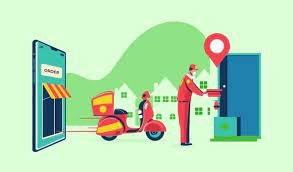Convenience is essential in the fast-paced digital world of today. Nowadays, individuals enjoy the convenience of getting anything from groceries and food to medications and retail goods directly from their cellphones. The mobile delivery app market is one of the fastest-growing industries in 2025 as a result of this rising demand.
Whether you’re an entrepreneur looking to launch a new startup or a business owner aiming to expand into on-demand delivery, creating your mobile delivery app can open up new opportunities. But how do you go from idea to launch? This step-by-step guide will help you understand the entire process of building a delivery app that’s both functional and user-friendly.
Step 1: Define Your Delivery App Idea
Before writing a single line of code, clarify your vision.
- Type of Delivery App:
- Food delivery (like Uber Eats or DoorDash).
- Grocery delivery (like Instacart).
- Medicine delivery.
- All-in-one multi-delivery app.
- Target Audience: Who will use your app? Urban customers? College students? Busy professionals?
- Unique Selling Point (USP): What will make your delivery app stand out from competitors?
A clear app concept will guide your design and development decisions.
Step 2: Research the Market & Competitors
The delivery app market is competitive. Study apps like Uber Eats, DoorDash, Instacart, and Zomato to understand:
- Features users love.
- Pain points customers complain about.
- Pricing and delivery models.
Use this research to identify gaps and opportunities for your app.
Step 3: Choose the Right Business Model
Your business model defines how your app will generate revenue. Common models include:
- Commission Model: Take a percentage from each order.
- Subscription Model: Charge customers or restaurants a monthly fee.
- Freemium Model: Offer free access with paid premium features.
- Advertisement Model: Allow restaurants or partners to advertise in the app.
Step 4: Plan the Features of Your Delivery App
A successful delivery app should have three main panels:
1. Customer Panel
- User registration & login.
- Search & browse products/restaurants.
- Real-time order tracking.
- Multiple payment options.
- Ratings & reviews.
2. Delivery Partner Panel
- Registration & profile management.
- Order acceptance/rejection.
- GPS navigation & tracking.
- Earnings history.
3. Admin Panel
- Manage customers, partners, and orders.
- Track deliveries.
- Analytics and reporting.
- Commission & revenue management.
Consider adding AI-powered features like smart recommendations, route optimization, or chatbot support for better engagement.
Step 5: Select the Technology Stack
The right tech stack ensures your app is scalable and efficient.
- Frontend Development: Flutter, React Native, Swift, Kotlin.
- Backend Development: Node.js, Django, Ruby on Rails.
- Database: MySQL, PostgreSQL, MongoDB.
- APIs & Services: Google Maps API (for navigation), Stripe/PayPal (for payments), Firebase (for notifications).
Step 6: Design a Seamless User Experience
A delivery app’s success depends heavily on ease of use.
- Keep the design simple and intuitive.
- Use attractive visuals and icons.
- Optimize navigation for one-handed use.
- Ensure the app runs smoothly on both iOS and Android devices.
Step 7: Develop the MVP (Minimum Viable Product)
Instead of building the full app right away, start with an MVP.
- Include only essential features (sign-up, search, order, payment, tracking).
- Test the app with a small user base.
- Collect feedback and improve before scaling.
MVP development saves time, reduces costs, and validates your business idea.
Step 8: Test Your App Thoroughly
Testing is crucial before launch.
- Functional Testing: Do all features work correctly?
- Usability Testing: Is the app easy to use?
- Performance Testing: Can the app handle multiple orders at once?
- Security Testing: Are payment and user details safe?
Step 9: Launch & Market Your App
Once your app is ready, launch it on App Store and Google Play.
- Use digital marketing: social media ads, influencer campaigns, and SEO.
- Offer discounts or referral bonuses to attract early users.
- Partner with local businesses for cross-promotion.
Step 10: Maintain & Scale Your Delivery App
The work doesn’t stop after launch.
- Gather user feedback.
- Regularly update features and fix bugs.
- Scale the app to new regions.
- Add advanced features like AI chatbots, delivery drones, or voice-based ordering as your business grows.
Final Thoughts
Building your mobile delivery app is a rewarding opportunity in 2025. With the right strategy, technology, and execution, you can create an app that not only meets customer needs but also competes with industry giants.
